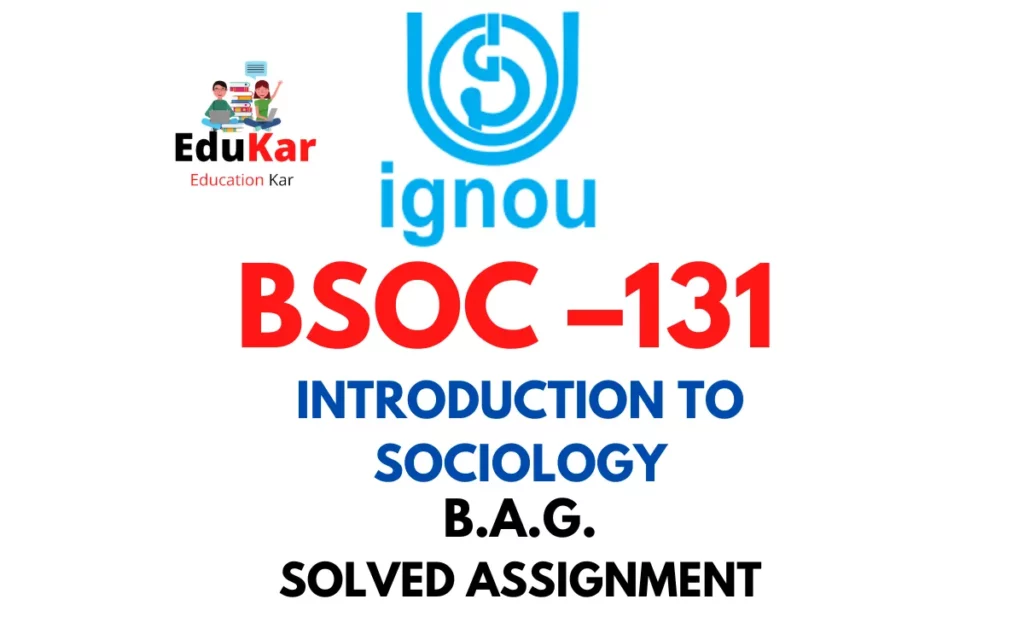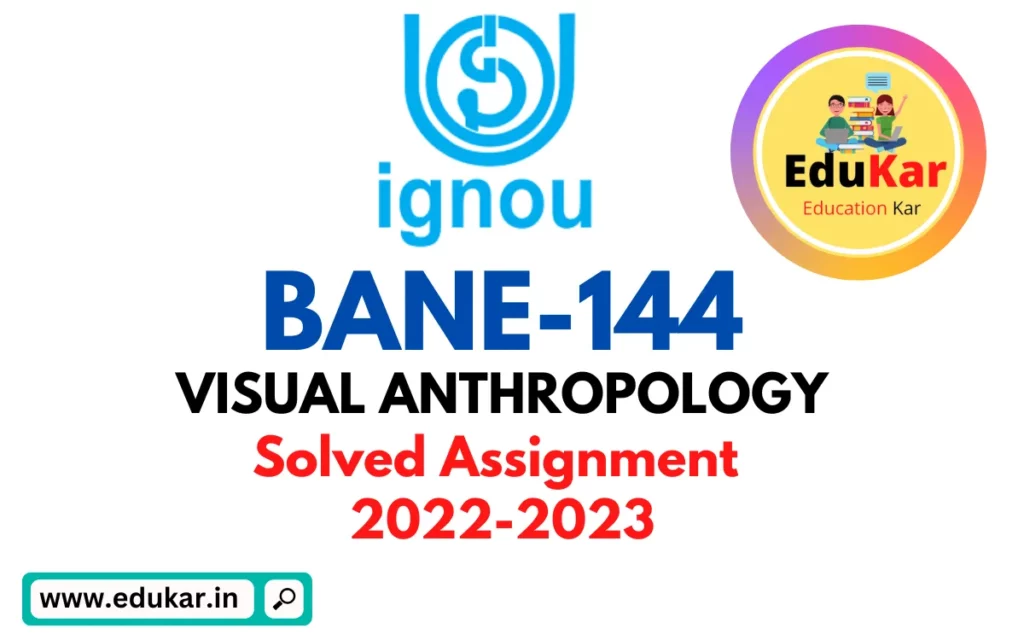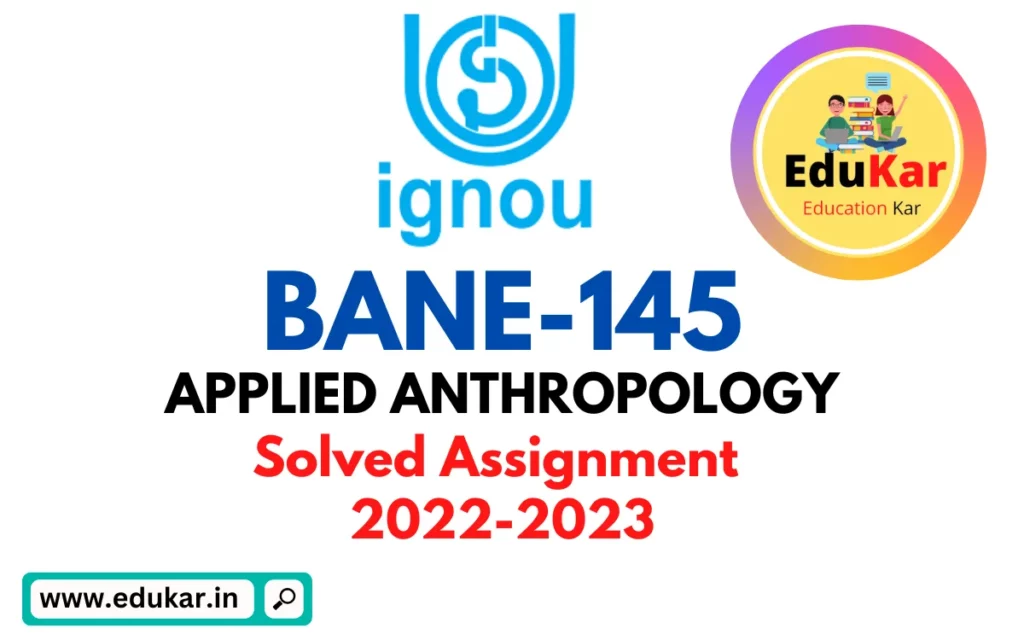Contents
- 1 Assignment – I
- 2 Answer the following in about 500 words each.
- 3 b. What is authenticity in tourism? Explain with suitable examples.
- 4 Assignment – II
- 5 Answer the following in about 250 words each. (Write Short Notes)
- 6 Answer the following questions in about 150 words each. 5X6=30
- 7 FAQs
- 7.1 What is the BAG 183 Tourism Anthropology course about?
- 7.2 What are the topics covered in the BAG 183 Tourism Anthropology solved assignment?
- 7.3 How can I obtain the BAG 183 Tourism Anthropology solved assignment?
- 7.4 How can I submit the BAG 183 Tourism Anthropology solved assignment?
- 7.5 Is the BAG 183 Tourism Anthropology solved assignment graded?
- 7.6 Is there a deadline for submitting the BAG 183 Tourism Anthropology solved assignment?

| Title | BANS 183: TOURISM ANTHROPOLOGY (BAG) Solved Assignment |
| University | IGNOU |
| Degree | Bachelor Degree Programme |
| Course Code | BAG |
| Course Name | Bachelor of Arts |
| Subject Code | BANS 183 |
| Subject Name | TOURISM ANTHROPOLOGY |
| Year | 2023 |
| Language | English |
| Assignment Code | BANS 183/ASST/TMA |
Assignment – I
Answer the following in about 500 words each.
a. Define anthropology. Discuss the role of anthropology in studying tourism.
Answer: Anthropology is the scientific study of human beings and human societies. It encompasses various subfields, including cultural anthropology, archaeology, linguistics, and physical anthropology. Anthropology seeks to understand the diversity of human cultures, societies, and ways of life, both past and present. It also examines how human beings interact with the natural environment and how they have evolved over time.
Cultural anthropology is the branch of anthropology that deals with the study of human cultures, beliefs, practices, and social organizations. Cultural anthropologists study the customs, traditions, and beliefs of different societies, and how they are passed down through generations. They also study how cultures change over time, and how they interact with each other. Cultural anthropology can provide valuable insights into the cultural dimensions of tourism. For example, it can examine how tourists and host communities perceive and construct meanings of tourism, how tourists’ expectations, experiences, and behaviors are shaped by their cultural backgrounds, and how these are interpreted by host communities.
Social anthropology is the branch of anthropology that deals with the study of human social organization. Social anthropologists study how human societies are organized, how they function, and how they change. They also study how different groups interact with each other and how power is distributed within a society. Social anthropology can provide valuable insights into the social dimensions of tourism, for example, how tourism can change social norms, relationships, and ways of life, how host communities respond to and manage tourism, including the dynamics of power and the negotiation of cultural identities.
Economic anthropology is the branch of anthropology that deals with the study of the economic aspects of human societies. Economic anthropologists study how societies produce, distribute, and consume goods and services, and how these activities are embedded in social and cultural contexts. Economic anthropology can provide valuable insights into the economic dimensions of tourism, such as the distribution of benefits and costs among different groups, the role of intermediaries and intermediaries in the tourism industry, and the impact of tourism on local livelihoods.
Anthropological perspectives on tourism can also provide a deeper understanding of the global and historical contexts that shape tourism, including the ways in which tourism is linked to broader processes of globalization, development, and cultural change. For example, anthropologists can examine how tourism has been shaped by colonialism, imperialism, and other forms of global inequality, and how these historical legacies continue to shape tourism today. They can also study how tourism is linked to broader trends in development, such as the rise of the middle class in developing countries, and how these trends are shaping tourism in different parts of the world.
Anthropological perspectives on tourism can also contribute to the development of sustainable tourism policies, and the management of tourism. Anthropologists can provide insights into how to minimize the negative impacts of tourism on host communities and the environment, while maximizing the benefits for local people. They can also provide recommendations on how to promote cultural understanding and respect between tourists and host communities, and how to manage the complex dynamics of power and identity that shape tourism.
b. What is authenticity in tourism? Explain with suitable examples.
Answer: Authenticity in tourism refers to the extent to which a tourist experience or destination is genuine, original, and true to its cultural or historical roots. It is the degree to which a tourist experience or destination is perceived as being real, unadulterated and unmodified by modern influences.
For example, a traditional village in a developing country may be considered authentic if it retains its traditional customs and practices, and if tourists have the opportunity to interact with local people and experience their way of life. On the other hand, a theme park that simulates a traditional village but is heavily commercialized and lacks real interactions with local people would not be considered authentic.
Authenticity is a complex concept that can be viewed from different perspectives. For example, from the perspective of tourists, authenticity may refer to the degree to which a destination or experience is perceived as being true to its cultural or historical roots. From the perspective of host communities, authenticity may refer to the degree to which their culture, heritage, and way of life are respected and protected. From the perspective of tourism planners and managers, authenticity may refer to the degree to which a destination or experience is developed in a way that is sustainable, socially responsible, and respectful of the host community and its culture.
Authenticity is an important concept in tourism because it is closely linked to the quality of the tourist experience. Tourists often seek out authentic experiences because they want to experience different cultures, traditions, and ways of life in a genuine and unadulterated way. Authenticity can also contribute to the development of sustainable tourism, as it can help to ensure that tourism development is respectful of local cultures and heritage, and that it benefits local communities.
One example of authenticity in tourism is the “Slow Cities” movement, which promotes small towns and villages that have managed to retain their traditional character, customs, and way of life, despite the pressures of modernization and globalization. These towns and villages offer tourists the opportunity to experience traditional culture, heritage, and ways of life in a genuine and unmodified way.
Another example of authenticity in tourism is the concept of “Ecotourism” which is a form of sustainable tourism that focuses on the protection of natural and cultural heritage. Ecotourism operators aim to provide tourists with an authentic and educational experience of the natural environment and local culture, while also promoting conservation and the sustainable development of local communities.
Assignment – II
Answer the following in about 250 words each. (Write Short Notes)
A. What is commodification? Discuss the commodification of religious sites and
national parks.
Answer: Commodification refers to the process of turning something into a commodity, or a product that can be bought and sold in the market. In the context of tourism, commodification refers to the process of turning a destination, attraction, culture, or experience into a product that can be marketed and sold to tourists.
The commodification of religious sites and national parks is a phenomenon that has been observed in many parts of the world. For example, many religious sites such as temples, shrines, and churches have been turned into tourist attractions, with entry fees and guided tours being offered to visitors. Similarly, many national parks and protected areas have been developed for tourism, with facilities such as visitor centers, campsites, and hiking trails being built to attract tourists.
One of the main concerns with the commodification of religious sites and national parks is that it can lead to the commercialization of culture and heritage. When religious sites and national parks are turned into tourist attractions, they are often sanitized and commercialized to appeal to a mass market, which can lead to the loss of their cultural and heritage significance. For example, religious sites may be turned into theme parks, with the original religious artifacts and architecture being replaced with replicas or souvenirs. National parks may also be developed with facilities such as hotels, golf courses, and amusement parks, which can lead to the destruction of natural habitats and the displacement of local communities.
Additionally, commodification of religious sites and national parks can also lead to the exploitation of local communities. For example, local communities may be forced to work in the tourist industry, with little control over the way in which their culture and heritage is represented or the benefits that they receive from tourism. Local communities may also be displaced from their traditional lands to make way for tourism development, which can lead to the loss of their cultural and economic livelihoods.
Another issue that can arise from the commodification of religious sites and national parks is the loss of authenticity. When religious sites and national parks are commercialized for tourism, the original religious or natural experiences may be altered, or replaced by artificial or staged experiences, which can lead to a loss of authenticity and a decline in the quality of the tourist experience.
b. Discuss preservation and conservation of two heritage sites in India.
Answer: India is home to a rich cultural heritage, with many heritage sites that are of great historical, architectural and cultural significance. Two of the most well-known heritage sites in India are the Taj Mahal and the Ajanta and Ellora Caves.
The Taj Mahal, located in Agra, Uttar Pradesh, is a white marble mausoleum built by the Mughal emperor Shah Jahan in memory of his third wife, Mumtaz Mahal. It is widely considered one of the most beautiful buildings in the world, and is a UNESCO World Heritage Site. The preservation and conservation of the Taj Mahal is of great importance, as it is one of the most visited tourist destinations in India and an important symbol of Indian culture and heritage.
The government of India has taken several measures to preserve and conserve the Taj Mahal, including the establishment of a monitoring system to track the condition of the building, the installation of air-pollution control equipment, and the development of a new sewage treatment plant to reduce pollution levels in the area. In addition, the government has also implemented strict visitor management systems to control the number of visitors at the site and to minimize the impact of tourism on the monument.
The Ajanta and Ellora Caves, located in the state of Maharashtra, are a series of rock-cut Buddhist, Hindu and Jain temples that date back to the 2nd century BCE. They are considered to be one of the most important examples of ancient Indian rock-cut architecture and are a UNESCO World Heritage Site. The preservation and conservation of the Ajanta and Ellora Caves is important as they are one of the most visited tourist destinations in India and a valuable part of India’s cultural heritage.
The government of India has implemented several measures to preserve and conserve the Ajanta and Ellora Caves. These include regular maintenance and restoration works, visitor management systems, and the creation of a buffer zone around the caves to minimize the impact of tourism. The government has also established an archaeological park to protect the surrounding area and has initiated various research and conservation programs to study and preserve the caves.
c. Describe tangible and intangible heritage with suitable examples.
Answer: Tangible heritage refers to physical or material objects and structures that have historical, cultural, or architectural significance. Examples of tangible heritage include monuments, buildings, artifacts, and landscapes. They can be observed and touched and include the Ajanta and Ellora Caves, the Great Wall of China, and the Pyramids of Egypt.
Intangible heritage, on the other hand, refers to non-physical aspects of culture such as customs, traditions, practices, and knowledge that are passed down from generation to generation. Examples of intangible heritage include traditional music, dance, storytelling, oral history, and religious practices. These cannot be touched or seen but can be experienced and passed on, for example, the traditional dances of the Hopi tribe in America, the traditional Irish music, and the traditional customs of the indigenous people of Australia.
Intangible heritage is often more difficult to preserve and conserve than tangible heritage because it is not a physical object, and it is often passed down through oral tradition. However, it is no less important in terms of cultural value and is an essential aspect of a community’s identity. Efforts are being made to document and preserve intangible heritage, such as through ethnographic research, audio and video recordings, and community-based programs.
Answer the following questions in about 150 words each. 5X6=30
a. Physical anthropology
Answer: Physical anthropology is a subfield of anthropology that focuses on the study of the biological and physical aspects of human beings and their closest relatives, the primates. This includes the study of human evolution, human variation and adaptation, human ecology and behavior, and the biology and behavior of non-human primates.
Physical anthropologists use a variety of methods to study human biology and evolution, including the analysis of bones, teeth, and DNA, as well as the study of living populations and their cultures. They also study the fossil record to understand the evolution of human anatomy, physiology, and behavior.
One of the main goals of physical anthropology is to understand the biological and cultural evolution of human beings and how humans have adapted to different environments. This includes understanding how human evolution is related to the evolution of other primates, such as chimpanzees and gorillas, and how human biology has changed over time in response to environmental factors.
b. Archaeological anthropology
Answer: Archaeological anthropology is a subfield of anthropology that focuses on the study of human culture and behavior through the examination of material remains, such as artifacts, architecture, and ecofacts. It encompasses the study of past cultures and societies, primarily through the excavation and analysis of archaeological sites and the interpretation of the artifacts and other materials found there. It also often involves the use of other anthropological subfields such as cultural anthropology, linguistic anthropology, and physical anthropology in order to understand the past societies.
c. Types of Tourism
Answer: There are various types of tourism that are categorized based on different factors such as the purpose of travel, the type of accommodation, and the activities that are undertaken during the trip. Some of the main types of tourism include:
- Recreational tourism: This type of tourism is undertaken for leisure and relaxation. It includes activities such as sightseeing, beach vacations, and skiing.
- Business tourism: This type of tourism is undertaken for business purposes, such as attending conferences, trade shows, and meetings.
- Cultural tourism: This type of tourism focuses on learning about the culture and history of a destination. It includes activities such as visiting museums, historical sites, and cultural events.
- Adventure tourism: This type of tourism involves activities such as hiking, climbing, and other outdoor activities.
- Ecotourism: This type of tourism focuses on sustainable travel and the conservation of natural and cultural resources. It includes activities such as wildlife watching, bird watching and visiting protected areas.
d. Local environment versus Tourist
The local environment refers to the natural and built surroundings that are familiar to the people who live in a particular place. This includes the landscape, climate, architecture, culture, and way of life of the community. On the other hand, the tourist environment refers to the places and experiences that are designed to attract and entertain visitors. These include popular tourist destinations, hotels, restaurants, and other amenities. One of the key differences between the local and tourist environments is the level of authenticity. The local environment is genuine and reflects the true culture and way of life of the people who live there, while the tourist environment is often a manufactured and sanitized version of the local culture, tailored to the expectations and preferences of visitors. This can result in a lack of authenticity and a disconnection from the true culture of the place.
e. Eco tourism
Answer: Ecotourism is a form of sustainable tourism that focuses on the conservation of natural and cultural resources while also providing benefits for local communities. This type of tourism is based on the principles of environmental protection, education, and community development.
One of the main goals of ecotourism is to minimize the negative impacts of tourism on the environment, while also promoting conservation efforts. This can involve using renewable energy sources, reducing waste, and promoting sustainable transportation options. It can also involve working with local communities to ensure that they are involved in the decision-making process and that they are able to benefit from tourism.
Ecotourism activities often include wildlife watching, bird watching, hiking, and camping in natural areas. It also includes visiting protected areas, such as national parks and wildlife refuges, as well as participating in conservation and research projects.
f. Edible identities
Answer: Edible identities refer to the ways in which food and cuisine are used to express and reinforce cultural and personal identities. Food and cuisine can be seen as powerful symbols of culture, tradition, and personal identity, and can serve as a means of expressing and preserving cultural heritage.
Edible identities can manifest in different ways, such as through traditional dishes and recipes passed down through generations, the use of local and seasonal ingredients, and the incorporation of specific cultural or religious practices into meal preparation and consumption.
Food and cuisine can also be used to reinforce ethnic, national, and personal identities, as well as to construct and challenge social hierarchies. For example, certain types of cuisine may be associated with higher social status or prestige, while others may be stigmatized.
FAQs
What is the BAG 183 Tourism Anthropology course about?
BAG 183 Tourism Anthropology is a course that explores the intersection of tourism and anthropology, examining the cultural, social, and economic impacts of tourism on host communities and the wider world.
What are the topics covered in the BAG 183 Tourism Anthropology solved assignment?
The topics covered in the BAG 183 Tourism Anthropology solved assignment may vary depending on the specific assignment, but they generally focus on the cultural, social, and economic impacts of tourism on host communities, as well as the ways in which tourism is shaped by cultural, social, and economic factors.
How can I obtain the BAG 183 Tourism Anthropology solved assignment?
ou can obtain the BAG 183 Tourism Anthropology solved assignment through Edukar.in
How can I submit the BAG 183 Tourism Anthropology solved assignment?
You can submit the BAG 183 Tourism Anthropology solved assignment through your university or college’s online submission system, or by handing it in to the instructor of the course in person.
Is the BAG 183 Tourism Anthropology solved assignment graded?
Yes, the BAG 183 Tourism Anthropology solved assignment is typically graded by the instructor of the course.
Is there a deadline for submitting the BAG 183 Tourism Anthropology solved assignment?
Yes, there is typically a deadline for submitting the BAG 183 Tourism Anthropology solved assignment, which will be set by the instructor of the course.















